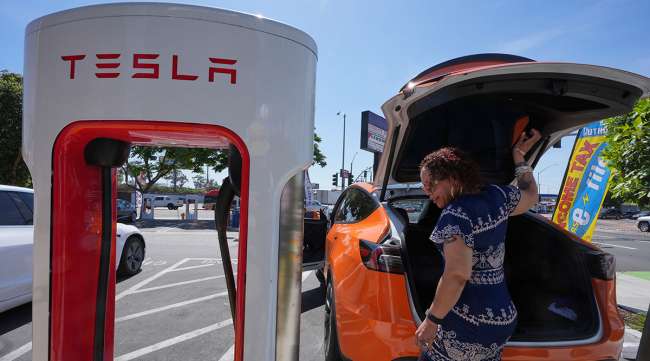Janelle Lowe prepares to charge her electric vehicle at a charging station Thursday, May 22, 2025, in Long Beach, Calif. (AP Photo/Damian Dovarganes)
The Trump administration’s plan to scrap federal incentives for electric vehicles will be a major speed bump for battery-powered transportation in the U.S., but not a brick wall, according to forecasts.
On July 3, Republicans in the U.S. House sent a bill to President Donald Trump’s desk that kills tax credits of up to $7,500 for EV customers that were part of the 2022 Inflation Reduction Act.
The White House has said former President Joe Biden’s initiative “promised much but delivered nothing.” However, the tax credits helped fuel an EV market far more robust and affordable than drivers enjoyed before the rebates kicked in two and a half years ago. Repealing them, combined with a flurry of other anti-EV policies put in place or being pursued by the Trump administration, will put a serious dent in sales.
U.S. adoption is set to trail the global average through 2040 and will knock the nation out of the top three EV markets, according to a recent BloombergNEF report. Last year’s version of the report had the country boasting higher-than-average sales starting in 2029.

Buckberg
Still, Elaine Buckberg, a former General Motors economist now at Harvard University’s Salata Institute for Climate and Sustainability, estimates that even with federal tax cuts disappearing, some 37% of new cars bought in 2030 will be electric. That’s down from a forecast of 48% if the current incentives remained. The factors propping up some of the demand are fairly straightforward: Electric cars are far better and cheaper than they used to be, and there are many more models to choose from.
“In the most likely scenario, you end up about two years behind on adoption,” Buckberg said. “I think [EVs] will be more resilient than people are thinking.”

The average price U.S. drivers pay for an EV has ticked slightly lower in the IRA era, from $64,700 in January 2023 to $59,900 in April, a 7.4% decline without adjusting for inflation, according to Edmunds.com. However, the range of options has widened dramatically.
When the IRA was passed, there were 34 types of EVs for sale in the U.S., with just 11 models below the average vehicle price of $47,500. Today, there are twice as many electric models to choose from, and 19 have below-average sticker prices. EV incentives in 17 states can bring the cost down even further for some buyers.
“You just have more non-luxury offerings,” Buckberg said. “You’re more likely to find the brand you want, the style you want, the size you want.”
Stephanie Valdez Streaty, a director at Cox Automotive, said carmakers and dealers are offering discounts that are often as generous or more so than government incentives. Dealer incentives on a Nissan Leaf, she said, mean “you can get that vehicle for less than $20,000” in some cases.
BNEF expects U.S. EVs will be as cheap or cheaper than gas-powered iterations by roughly 2028. Goldman Sachs estimates that Rubicon could be crossed even sooner.

There’s evidence that a majority of Americans are at least electric-curious. Nearly 60% of U.S. vehicle shoppers are “very” or “somewhat” likely to purchase an EV, according to a May JD Power survey — levels unchanged from a year ago. What’s more, concerns about purchase price and cost of ownership have declined over the past 12 months.
Still, the loss of federal incentives will hit the lower end of the market particularly hard. “The people who have the means to go buy a Rivian or a Lucid are still going to go do that,” said Ingrid Malmgren, the senior policy director at advocacy group Plug In America. “The impact, like so much of the rest of this bill, is inordinately going to be paid for by lower-income Americans.”
Rolling back EV tax credits is also only part of how the Trump administration is favoring internal combustion models. It has frozen a $5 billion federal plan to build charging stations, primarily along rural interstate corridors and in low-income communities. The White House also has promised to lower regulations on tailpipe emissions and moved to block a California policy to ban gasoline-powered car sales by 2035.
Factoring in all of these policy shifts will slow EVs’ momentum even further than the IRA cuts: BNEF forecasts that just 27% of the U.S. market to be electric by 2030, down from the 48% share it estimated a year ago, and Buckberg expects a similar slowdown.
Outside the U.S., however, EVs remain on a tear thanks to a drop in battery prices and a wave of low-price models rolling out of Chinese factories. BNEF expects one in four new cars sold this year — some 22 million cars and trucks — to come with a plug, a 25% increase over 2024. Two-thirds of those sales will be in China.






